Southern Texas 2011
17-24 Apr 2011
by
Henry Detwiler
Starting with a pair of Whooping Cranes on Sunday the 17th, and ending with a vibrant Prothonotary Warbler, twelve Swedes and I tallied over 260 of our feathered friends in a week of exciting birding.
261 species seen & heard Click here for bird checklist
Click on
thumbnail pictures for full-sized photos.

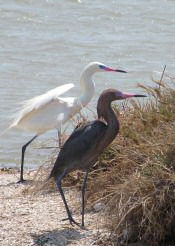
Light & Dark phase Reddish Egrets
As we birded our way up the Intracontinental Waterway someone spotted a pair of Whooping Cranes, and we all got to see these majestic birds winging their way over the marsh. Once we reached the rookeries, we were treated to close-up views of nesting Reddish & Snowy Egrets, Tricolored and Great-blue Herons, and Black-crowned Night Herons.
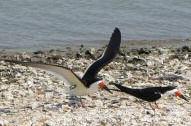
Black Skimmers
|
On Sunday morning we boarded the "Skimmer" and headed out to Aransas Bay. Royal Terns were our constant companions, and once we reached the myriad islands in the shallows, we started ticking off shorebirds and waders, too.
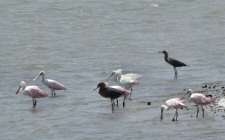
Roseate Spoonbills & Reddish Egrets
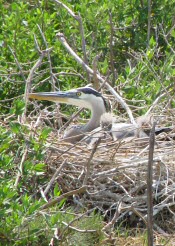
Great Blue Heron on nest
|
The next day we started before dawn at Brownsville, finding a Tropical Kingbird and Green Parakeets. From there we drove to the newly re-opened Sabal Palm Sanctuary, where we watched some of the quintessential Lower Rio Grande species: Plain Chachalaca, Long-billed Thrasher, Buff-breasted Hummingbird, and Olive Sparrow.
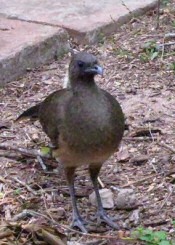
Plain Chachalaca at Sabal Palm Sanctuary
|
No fallout at South Padre Island, but we did find a few singleton warblers and Rose-breasted Grosbeak. Our final stop at La Feria Sod Farms was excellent, with both watered and dry sod. Good birds included Buff-breasted, Upland, and Pectoral Sandpipers, and Golden Plovers.
The following morning we braved the stiff winds and did some owling at Bentsen State Park. The best birds were a mother Pauraque on her nest with a large chick under her wing, an Elf Owl scolding us from a branch not 6 feet over our head, an incessantly singing Northern Beardless-Tyrannulet in a tree right at dawn, and the handsome Ringed Kingfisher. At Estero Llano Grande we surveyed the wetlands and then located two Clay-colored Robins in the woodlands. After lunch we headed west to Salineno and Chapeno, where our prize was a striking Muscovy Duck! |
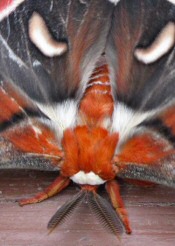
Awesome moth at Neal's Lodges
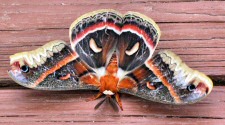
|
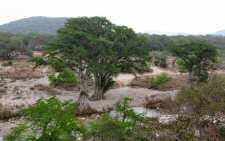
Rio Frio from Neal's Lodges
At San Ignacio a few lucky individuals got a Red-billed Pigeon, and then we headed north to Neal's Lodges in the "Hill Country." The birds here were plentiful, and in short order we saw Black-crested Titmouse, Lesser Goldfinch, Pine Siskin, Black-chinned Hummingbird, and many others. The following morning we saw a number of Black-capped Vireos and a singing Golden-cheeked Warbler, before making the long drive east to Winnie.
|
| Along the way to eastern Texas we stopped at Attwater NWR, with its large expanses of prairies. Here we had fine looks at several more Upland Sandpipers, close-up Crested Caracara, Cassin's Sparrow, an immature Yellow-crowned Night-Heron, a White-tailed Hawk, a large flock of Dickcissels, and several Northern Bobwhites. |
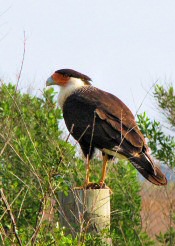
Crested Caracara at Attwater NWR |
|
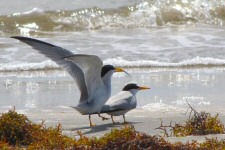
Least tern mating ritual
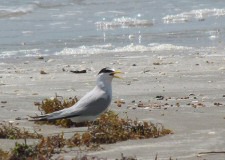
Least Tern (above and below)

|
At High Island the next morning we all had great looks at Palm Warbler and a brilliant Blackburnian Warbler. From there we headed to Bolivar Peninsula, where we got Clapper Rail, Seaside Sparrow, and Nelson's Sparrow perched up in the reeds. A walk down the Bolivar Audubon Sanctuary gave us incredible views of breeding Least Terns, fly-by Royal Terns, waders, and a wide assortment of shorebirds. Foremost among these were the plovers: Black-bellied, Semipalmated, Wilson's, Snowy, and Piping.
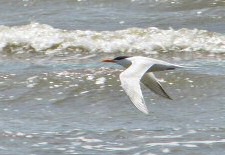
Royal Tern
|
The afternoon found us at Sabine Woods, not far from Beaumont. The drip and the pond in the middle of this hammock were loaded with birds, even though it wasn't considered a "fallout." We were happy to record a Yellow-billed Cuckoo, Western Wood Pewees, Scarlet Tanagers, Brown-crested Flycatchers, several vireos and warblers, and more Painted Buntings. Rarest of all was a Philadelphia Vireo that several of our team got good looks at.
|
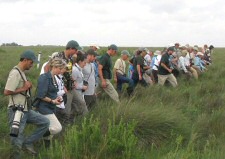
The Yellow Rail hunt at Anahuac NWR
We began our last full day of birding at Anahuac NWR. About 60 eager folks assembled and were escorted to a closed area of the refuge known as Alligator Marsh. Those with thick pants and boots were invited to form an impenetrable human chain, through which no wily birds could slip through. Our goal was the Yellow Rail, but we were also on the lookout for other marsh birds.
|
As the stompers moved forward, we saw some nice birds taking to the air and fleeing: Sedge Wren, Seaside Sparrow, and King Rail. As we stumbled along through cow troughs, got spiked on sharp marsh grasses, and fell over clumps of thick vegetation, our leader David called for more frequent breaks.
After about thirty minutes of marching, on the final leg back towards the vehicles, someone cried out "Rail!" Reenergized, we quickly formed a human circle around the spot where the rail was last seen disappearing into the grass. As we closed in on the rail, it finally flushed and we had excellent looks at what was a "life" Yellow Rail for most observers. |
After our rail hike, we did a circuit around the refuge. Aside from lots of friendly-looking alligators, we spotted a number of waders, a few Least Bitterns, Boat-tailed Grackles, and several King Rails.
|
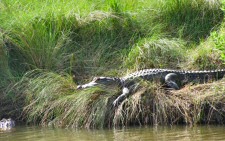
American Alligator, Anahuac NWR
|
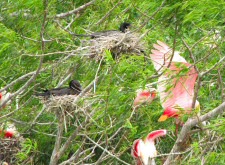
Neotropic Cormorants & Roseate Spoonbills
In the rookery, we had wonderful views of nesting and feeding Roseate Spoonbills, Neotropic Cormorants, and various egret and herons..
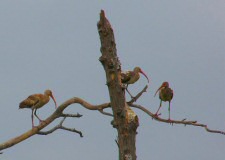
Immature White Ibis
|
That afternoon we toured the various habitats in High Island, where we added Yellow-throated Vireo, Belted Kingfisher, American Redstart, and Northern Waterthrush.
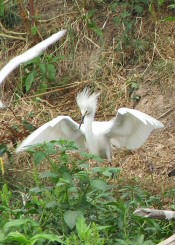 Snowy Egret
Snowy Egret On our way north to Houston, we made a quick stop at White Memorial Park, where we were delighted to find the massive Pileated Woodpecker and the diminutive Tufted Titmouse. |
On our last morning we drove over to W.G.Jones State Forest and before long had located Red-cockaded and Red-headed Woodpeckers, and the tiny Brown-headed Nuthatch. Our final birding of the trip was done at Jessie S. Jones County Park, not far from George Bush International Airport. Here we watched a couple of lovely Prothonotary Warblers, heard a Swainson's Warbler, and saw several Acadian Flycatchers. One lucky soul even spied a Bay-breasted Warbler. At the airport we said our goodbyes, and left with a fat checklist of outstanding Texas birds! |
|